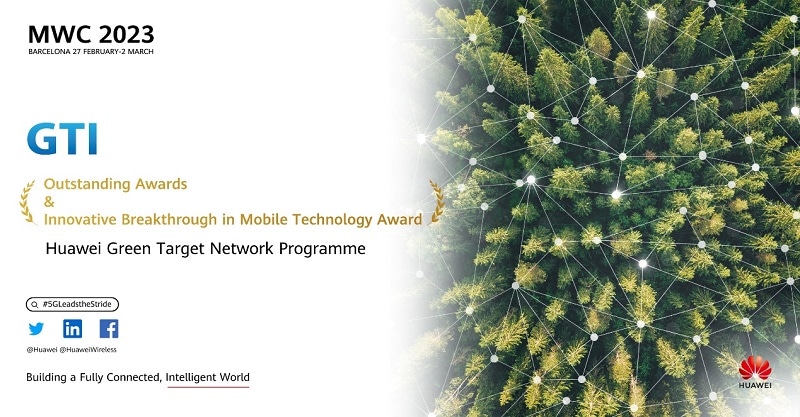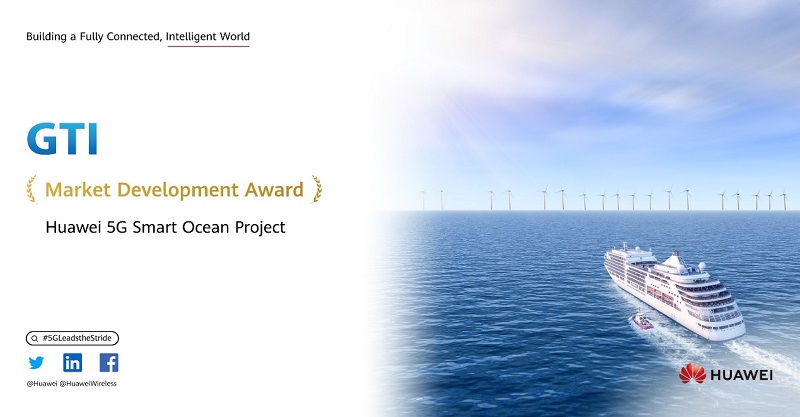[Barcelona, Spain, March 3, 2023] At Mobile World Congress (MWC) Barcelona 2023, Huawei took home multiple GTI Awards.
Huawei’s Green Target Network programme scooped the GTI ‘Innovative Breakthrough in Mobile Technology Award’ and ‘Outstanding Award’, while its 5G Smart Ocean project won the GTI ‘Market Development Award’ for its outstanding contributions to the digital transformation of the maritime industry.
Huawei’s Green Target Network Programme Scooped GTI ‘Innovative Breakthrough in Mobile Technology Award’ and ‘Outstanding Award’
This is the second green solution and energy saving project by Huawei that won this heavyweight award following the 5Green Solutions. This is a testament to Huawei’s substantial contributions to technological innovation and sustainable development in energy saving field, as well as Huawei’s continuous efforts in energy-saving industry cooperation over the past few years.
 Huawei’s Green Target Network programme wins GTI ‘Innovative Breakthrough in Mobile Technology Award’ and ‘Outstanding Award’
Huawei’s Green Target Network programme wins GTI ‘Innovative Breakthrough in Mobile Technology Award’ and ‘Outstanding Award’
As network traffic is surging, global operators are torn between achieving zero carbon emission and guaranteeing optimal user experience. In response to the global climate action, Huawei takes multiple key measures in industry cooperation, industry standards, and energy saving technology innovation through green target network projects. These measures help operators achieve exponential network traffic growth without increasing energy consumption, significantly improving energy efficiency while reducing carbon emissions of wireless networks.
- Three solutions: The deep dormancy feature of AAU enables an energy efficiency improvement from 80% to 99%. Technologies such as Massive MIMO, ultra-wideband, and SDIF enable Huawei’s RF modules to achieve industry-leading energy performance while ensuring coverage and user experience. Thanks to the intelligent energy saving for base stations, the entire-site collaboration enables real-time adjustment of site coordinates based on traffic load, saving more than 15% of site power consumption. Furthermore, the intelligent energy-saving technology iPowerStar reduces the network-wide power consumption by 30%.
- Two platforms: Huawei supported industry partners to set up two industry cooperation platforms for building green and low-carbon networks at home and abroad. Under the initiative and leadership of the Green Union and NGMN Green Future Network Project, the industry works together to define standards for evaluating network energy saving and promote the technological innovation in this regard.
- One network energy efficiency standard: Huawei actively engaged in industry cooperation, supported industry in jointly defining the industry’s first QoS-based energy efficiency measurement indicator NEE 2.0, which has been successfully approved by international standards organizations such as ITU, ETSI, and CCSA, providing a benchmark for energy saving in the ICT industry.
Aaron Jiang, President of Huawei Wireless SingleRAN Product Line, said: “The green target network programme has been adopted in Asia Pacific, Europe, the Middle East, and Africa. The substantial energy-saving gains and user experience assurance are proof of Huawei’s efforts in developing energy-saving products and technologies. In the future, Huawei will continue to improve energy efficiency, apply more and more intelligent technologies, and create innovative products to achieve optimal network performance and energy saving.”
Huawei’s 5G Smart Ocean Project Won the GTI ‘Market Development Award’
 Huawei wins the GTI ‘Market Development Award’ for the 5G Smart Ocean project
Huawei wins the GTI ‘Market Development Award’ for the 5G Smart Ocean project
China boasts a coastline spanning 18,000 km, and it is home to the country’s most economically dynamic regions. The waters of China that stretch 50 to 100 km off the shore are often economically exploited for fish breeding rafts, coastal tourism, offshore wind power, and maritime and fishery law enforcement. Many coastal provinces in China have proposed to leverage ICT technologies to promote maritime economic development and transformation for 2021 to 2025, in which coastal mobile broadband will play a pivotal role.
Together with Chinese telecom operators, Huawei has long begun to actively deploy coastal 5G networks to cater for data and voice requirements of those working at sea and on farms along the coastline, to stimulate the development of the maritime economy. The allocation of 5G low-band spectrum makes it possible for these operators to economically deploy coastal 5G networks on a large scale. Thanks to significantly stronger network coverage, the operators have built a multi-band, multi-layer, and multi-cell three-dimensional network. TDD+FDD coordination achieves optimal network coverage and capacity. In heavily loaded hotspots, high-band spectrum is used to deliver high capacity for users.
Li Jie, Vice President of Huawei’s Wireless 5G<E TDD Product Line, said: “As a leading telecom equipment vendor, we are proud to work with operators to support the digital transformation of the maritime industry with leading 5G solutions.” Considering the disparity between offshore and terrestrial radio propagation characteristics, the operators and Huawei have worked together to build a dedicated propagation model for offshore areas based on the measurement results to optimize network configuration and deployment models. With the help of these technologies, the operators have achieved ultra-wide signal coverage in offshore areas.
This three-dimensional coastal 5G network not only enhances communication between those working at sea and along the coast, it also significantly improves mariculture efficiency, and extensively supports industry development and regulation of coastal areas.
PR Archives: Latest, By Company, By Date